
Limburg an der Lahn is the district seat of Limburg-Weilburg in Hesse, Germany.

Saint Boniface, born Winfrid in the Devon town of Crediton, England, was a leading figure in the Anglo-Saxon mission to the Germanic parts of the Frankish Empire during the 8th century. He organised significant foundations of the Catholic Church in Germany and was made archbishop of Mainz by Pope Gregory III. He was martyred in Frisia in 754, along with 52 others, and his remains were returned to Fulda, where they rest in a sarcophagus which became a site of pilgrimage. Boniface's life and death as well as his work became widely known, there being a wealth of material available—a number of vitae, especially the near-contemporary Vita Bonifatii auctore Willibaldi, legal documents, possibly some sermons, and above all his correspondence. He became the patron saint of Germania, known as the "Apostle of the Germans".
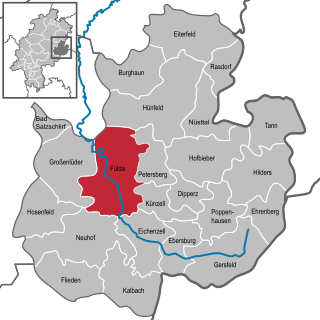
Fulda is a city in Hesse, Germany; it is located on the river Fulda and is the administrative seat of the Fulda district (Kreis). In 1990, the town hosted the 30th Hessentag state festival.

Heidesheim am Rhein is a former Ortsgemeinde – a municipality belonging to a Verbandsgemeinde, a kind of collective municipality – in the Mainz-Bingen district in Rhineland-Palatinate, Germany. Since July 2019, it is part of the town Ingelheim am Rhein. It was the administrative seat of the former Verbandsgemeinde of Heidesheim am Rhein, which also included the Ortsgemeinde of Wackernheim. Heidesheim was one of the biggest municipalities in Rhenish Hesse.

Seligenstadt is a town in the Offenbach district in the Regierungsbezirk of Darmstadt in Hesse, Germany. Seligenstadt is one of Germany's oldest towns and was already of great importance in Carolingian times.

Hadamar is a small town in Limburg-Weilburg district in Hessen, Germany.
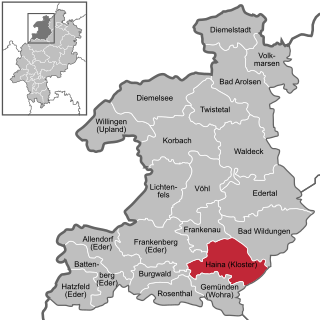
Haina (Kloster) is a community in Waldeck-Frankenberg in northwest Hesse, Germany.

Villmar is a market village in the Limburg-Weilburg district in Hesse, Germany. The community is the centre for quarrying and processing the so-called Lahn Marble.

The Princely Abbey of Stavelot-Malmedy, also Principality of Stavelot-Malmedy, was an ecclesiastical principality of the Holy Roman Empire. Princely power was exercised by the Benedictine abbot of the imperial double monastery of Stavelot and Malmedy, founded in 651. Along with the Duchy of Bouillon and the Prince-Bishopric of Liège, it was one of only three principalities of the Southern Netherlands that were never part of the Spanish Netherlands, which belonged to the Burgundian Circle while the principalities belonged to the Lower Rhenish Imperial Circle.
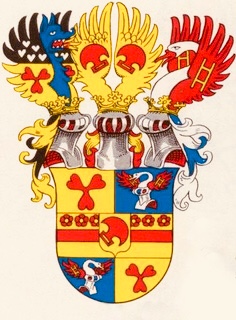
Franckenstein is the name of a Franconian, noble family in Germany, descendants from the Lords of Lützelbach from Höchst im Odenwald, respectively their offspring, the Dynasts of Breuberg.

The Rheingau Musik Festival (RMF) is an international summer music festival in Germany, founded in 1987. It is mostly for classical music, but includes other genres. Concerts take place at culturally important locations, such as Eberbach Abbey and Schloss Johannisberg, in the wine-growing Rheingau region between Wiesbaden and Lorch.

The Liebenau monastery was a Dominican monastery. It was located outside the city gates of Worms in today's Worms-Hochheim district.
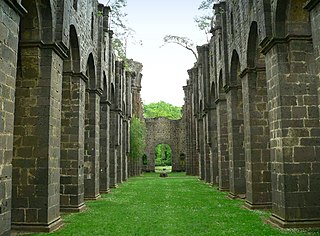
Arnsburg Abbey is a former Cistercian monastery near Lich in the Wetterau, Hesse, Germany. It was founded by monks from Eberbach Abbey in 1174. Although heavily damaged in the Thirty Years' War it was rebuilt later in the 17th century and prospered in the 18th century, when much of the abbey was rebuilt in Baroque style.

The Cross of Mathilde is an Ottonian processional cross in the crux gemmata style which has been in Essen in Germany since it was made in the 11th century. It is named after Abbess Mathilde who is depicted as the donor on a cloisonné enamel plaque on the cross's stem. It was made between about 1000, when Mathilde was abbess, and 1058, when Abbess Theophanu died; both were princesses of the Ottonian dynasty. It may have been completed in stages, and the corpus, the body of the crucified Christ, may be a still later replacement. The cross, which is also called the "second cross of Mathilde", forms part of a group along with the Cross of Otto and Mathilde or "first cross of Mathilde" from late in the preceding century, a third cross, sometimes called the Senkschmelz Cross, and the Cross of Theophanu from her period as abbess. All were made for Essen Abbey, now Essen Cathedral, and are kept in Essen Cathedral Treasury, where this cross is inventory number 4.

The Cross with large enamels, or Senkschmelz Cross, known in German as the Senkschmelzen-Kreuz or the Kreuz mit den großen Senkschmelzen is a processional cross in the Essen Cathedral Treasury which was created under Mathilde, Abbess of Essen. The name refers to its principal decorations, five unusually large enamel plaques made using the senkschmelz technique, a form of cloisonné which looks forward to champlevé enamel, with a recessed area in enamel surrounded by a plain gold background, and distinguishes it from three other crosses of the crux gemmata type at Essen. The cross is considered one of the masterpieces of Ottonian goldsmithing.
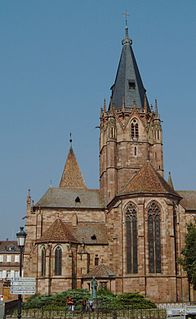
Weissemburg Abbey, also Wissembourg Abbey, is a former Benedictine abbey in Wissembourg in Alsace, France.

The pax was an object used in the Middle Ages and Renaissance for the Kiss of Peace in the Catholic Mass. Direct kissing among the celebrants and congregation was replaced by each in turn kissing the pax, which was carried around to those present. The form of the pax was variable but normally included a flat surface to be kissed. Often the pax was held out with a long handle attached, and it seems to have been given a wipe with a cloth between each person. Some paxes are very elaborate and expensive objects, and most survivals fall into this class, but the great majority were probably very simple wood or brass pieces. It was usual to include an image, usually of or including the Virgin Mary or Jesus Christ.

The Talisman of Charlemagne is a 9th-century Carolingian reliquary encolpion that may once have belonged to Charlemagne and is purported to contain a fragment of the True Cross. It is the only surviving piece of goldwork which can be connected with Charlemagne himself with some degree of probability, but the connection has been seriously questioned. The talisman is now kept in Rheims in the Palace of Tau.

The Trier Cathedral Treasury is a museum of Christian art and medieval art in Trier, Germany. The museum is owned by the Roman Catholic Diocese of Trier and is located inside the Cathedral of Trier. It contains some of the church's most valuable relics, reliquaries, liturgical vessels, ivories, manuscripts and other artistic objects. The history of the Trier church treasure goes back at least 800 years. In spite of heavy losses during the period of the Coalition Wars, it is one of the richest cathedral treasuries in Germany. With the cathedral it forms part of a UNESCO World Heritage Site.

Marienstatt Abbey is a Cistercian monastery and a pilgrimage site in Streithausen, Westerwaldkreis, Rhineland-Palatinate, in the Nister valley near Hachenburg.




















